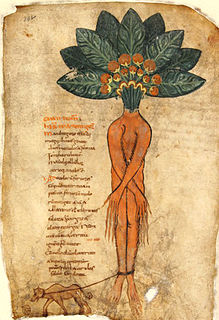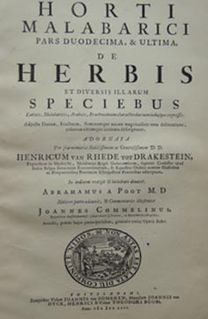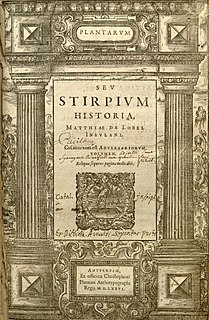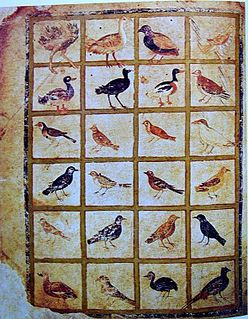 W
WA herbal is a book containing the names and descriptions of plants, usually with information on their medicinal, tonic, culinary, toxic, hallucinatory, aromatic, or magical powers, and the legends associated with them. A herbal may also classify the plants it describes, may give recipes for herbal extracts, tinctures, or potions, and sometimes include mineral and animal medicaments in addition to those obtained from plants. Herbals were often illustrated to assist plant identification.
 W
WChinese Medical Herbology and Pharmacology is a textbook on Chinese herbology by John and Tina Chen. It includes descriptions and illustrations of traditional use of Chinese herbs, and also covers their historical usage.
 W
WColóquios dos simples e drogas he cousas medicinais da Índia e assi dalgũas frutas achadas nella onde se tratam algũas cousas tocantes a medicina, pratica, e outras cousas boas pera saber is a work of great originality published in Goa on 10 April 1563 by Garcia de Orta, a Portuguese Jewish physician and naturalist, a pioneer of tropical medicine.
 W
WDe materia medica is a pharmacopoeia of medicinal plants and the medicines that can be obtained from them. The five-volume work was written between 50 and 70 CE by Pedanius Dioscorides, a Greek physician in the Roman army. It was widely read for more than 1,500 years until supplanted by revised herbals in the Renaissance, making it one of the longest-lasting of all natural history and pharmacology books.
 W
WExoticorum libri decem is an illustrated zoological and botanical compendium in Latin, published at Leiden in 1605 by Charles de l'Écluse.
 W
WThe Gart der Gesundheit was edited in 1485. It was written by Johann Wonnecke von Kaub and it is one of the first printed herbals in German. It was often reprinted until the 18th century. The Gart der Gesundheit is an important late medieval work concerning the knowledge of natural history, especially that of medicinal plants. In 435 chapters 382 plants, 25 drugs from the animal kingdom and 28 minerals are described and illustrated. The book was edited by Peter Schöffer in Mainz. Together with the Latin Herbarius moguntinus and the Latin Hortus sanitatis, the Gart der Gesundheit belongs to the "Group of Mainz herbal incunabula."
 W
WThe Grandes Heures of Anne of Brittany is a book of hours, commissioned by Anne of Brittany, Queen of France to two kings in succession, and illuminated in Tours or perhaps Paris by Jean Bourdichon between 1503 and 1508. It has been described by John Harthan as "one of the most magnificent Books of Hours ever made", and is now in the Bibliothèque nationale de France as Ms lat. 9474. It has 49 full-page miniatures in a Renaissance style, and more than 300 pages have large borders illustrated with a careful depiction of, usually, a single species of plant.
 W
WThe Grete Herball is an Early Modern encyclopedia and the first illustrated herbal produced in English. It is preceded by Richard Banckes's unillustrated Herball (1525), which was the first printed English herbal ever produced. The Grete Herball is a single volume compendium which details the medicinal properties of plants and some non-botanical items according to the system of humoralism. Confirmed editions were printed between 1526 and 1561, with many still in existence today. Its full title is "The grete herball: whiche geueth parfyt knowlege and under standyng of all maner of herbes & there gracyous vertues whiche god hath ordeyned for our prosperous welfare and helth: for they hele & cure all maner of dyseases and sekenesses that fall or mysfortune to all maner of creatoures of god created: practysed by many expert and wyse maysters, as Aucienna & other &c."
 W
WPseudo-Apuleius is the name given in modern scholarship to the author of a 4th-century herbal known as Pseudo-Apuleius Herbarius or Herbarium Apuleii Platonici. The author of the text apparently wished readers to think that it was by Apuleius of Madaura, the Roman poet and philosopher, but modern scholars do not believe this attribution. Little or nothing else is known of Pseudo-Apuleius apart from this.
 W
WHerbarius moguntinus or Aggregator practicus de simplicibus is an illustrated Latin herbal which was edited and printed in 1484 by Peter Schöffer in Mainz. Together with the German herbal Gart der Gesundheit and the Latin herbal Hortus sanitatis, Herbarius moguntinus belongs to the so-called "Group of Mainz Herbal Incunabula."
 W
WHistoria medicinal de las cosas que se traen de nuestras Indias Occidentales is the standard title for a survey by Nicolás Monardes (1493–1588), Spanish physician and botanist. It appeared in successive editions under varying titles, gradually enlarged, in 1565, 1569 and 1574, followed by an unchanged reprint in 1580.
 W
WHortus Malabaricus is a 17th-century botanical treatise on the medicinal properties of flora of the Malabar coast ). It was compiled by Hendrik van Rheede, the Governor of Dutch Malabar from 1669 to 1676. Itty Achudan, a distinguished herbalist from the ancient traditional Ezhava physicians of Kerala, was Van Rheede's key informant who disclosed the Ayurvedic traditional knowledge about the plants of Malabar to him. Hortus Malabaricus was published posthumously in Amsterdam between 1678 and 1693. English and Malayalam translations of Hortus Malabaricus were published by University of Kerala in 2003 and 2008 respectively, which was largely due to the efforts of Professor K. S. Manilal, an Emeritus of the University of Calicut who devoted over 35 years of his life to research for the translation and annotation work of the original text of Hortus Malabaricus in Latin.
 W
WThe Hortus Sanitatis, a Latin natural history encyclopaedia, was published by Jacob Meydenbach in Mainz, Germany in 1491.
 W
WKöhler's Medicinal Plants is a German herbal written principally by Hermann Adolph Köhler, and edited after his death by Gustav Pabst. The work was first published in the late 19th century by Franz Eugen Köhler of Gera. Its complete title is Köhler's Medizinal-Pflanzen in naturgetreuen Abbildungen mit kurz erläuterndem Texte : Atlas zur Pharmacopoea germanica, austriaca, belgica, danica, helvetica, hungarica, rossica, suecica, Neerlandica, British pharmacopoeia, zum Codex medicamentarius, sowie zur Pharmacopoeia of the United States of America.
 W
WMateria medica is a Latin term from the history of pharmacy for the body of collected knowledge about the therapeutic properties of any substance used for healing. The term derives from the title of a work by the Ancient Greek physician Pedanius Dioscorides in the 1st century AD, De materia medica, 'On medical material'.
 W
W'Plantarum seu stirpium historia' is an illustrated botanical text by the Flemish physician Lobelius (Matthias de l'Obel and published in Antwerp in 1576. Later, he translated it into Flemish in 1581 with the title Kruydtboeck. This was l'Obel's second work, following publication of the Stirpium adversaria nova in London in 1570. This work was intended as a companion publication to his Stirpium adversaria nova, and incorporates a revised version of the latter, as Nova stirpium adversaria.
 W
WThe Tractatus de Herbis is an illustrated treatise of medicinal plants painted in 1440. It is housed under shelfmark Sloane 4016 in the British Library, in London.
 W
WThe Vienna Dioscurides or Vienna Dioscorides is an early 6th-century Byzantine Greek illuminated manuscript of De materia medica by Dioscorides in uncial script. It is an important and rare example of a late antique scientific text. The 491 vellum folios measure 37 by 30 cm and contain more than 400 pictures of animals and plants, most done in a naturalistic style. In addition to the text by Dioscorides, the manuscript has appended to it the Carmen de herbis attributed to Rufus, a paraphrase of an ornithological treatise by a certain Dionysius, usually identified with Dionysius of Philadelphia, and a paraphrase of Nicander's treatise on the treatment of snake bites.